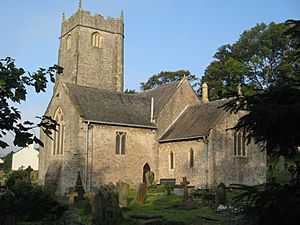Church of St John the Baptist, Llanblethian facts for kids

The Church of St John the Baptist in 2008
|
|
| Lua error in Module:Location_map at line 420: attempt to index field 'wikibase' (a nil value). | |
| OS grid reference | SS 984 740 |
|---|---|
| Location | Llanblethian, Vale of Glamorgan |
| Country | Wales, United Kingdom |
| Denomination | Church in Wales |
| Website | Church of St John the Baptist |
Quick facts for kids History |
|
| Founded | 12th century |
| Dedication | John the Baptist |
| Architecture | |
| Heritage designation | Grade I |
| Architectural type | Church |
| Style | Medieval |
The Church of St John the Baptist is a very old church in Llanblethian, a village in the Vale of Glamorgan, south Wales. People believe it was built way back in the 12th century. This church has a special tower that looks like towers found more often in the southwest of England.
The church was greatly repaired in the late 1800s by an architect named C. B. Fowler. On February 22, 1963, the Church of St John was given a special status. It became a Grade I listed building, meaning it's a very important historical building.
Contents
A Look at the Church's History
The Church of St John the Baptist was first mentioned in a document from the mid-1100s. This document showed that a place called Tewkesbury Abbey owned the church. We can tell how old the church is by looking at its short, low chancel, which is the part of the church near the altar. This part was definitely built in the 12th century.
The church's tower is built in a style called the Somerset style. It is said that Anne Neville gave this tower to the church in 1477. Anne Neville was a very important lady. She was the heiress to the lordship of Glamorgan and the wife of Richard, Duke of Gloucester. He later became King Richard III of England. A record from 1721 says that Anne was responsible for parts of other churches too.
Restoration Work in the 1800s
In the 1890s, the church had a big restoration project. This work was led by C. B. Fowler, an architect from Cardiff. The inside of the church was heavily changed. The old plaster was taken off the walls, showing the bricks and mortar underneath.
One good thing about this work was that it showed off the beautiful oak roof. However, many of the old wooden beams from the Middle Ages had to be replaced. During the restoration, a secret room called a crypt was found under the vestry. Inside, they found the remains of about 200 bodies! No one knows for sure if this crypt was a place where bodies were moved from the graveyard or if it was a mass burial site from a historical event.
Changes in Church Status
In 1994, the Llanblethian church changed its role. It used to be the main church for the area of Llanblethian and Cowbridge. This meant the vicar of Llanblethian was in charge of other churches nearby. But this main church role was moved to the church in Cowbridge.
The church was officially listed as a Grade I building on February 22, 1963. It was given this status because it is a 'Medieval parish church with much surviving detail and fine tower'. This means it's a very old church with many original parts and a beautiful tower.
Church Design and Features
The original part of the church, the 12th-century chancel, has a special single window on its north wall. The stone around this window is original. The church's tower is in the Somerset style. This style is similar to the tower of St John the Baptist Church, Cardiff, which is the oldest medieval church in the capital city.
The tower of Llanblethian church looks quite unique for its location. Its features are more common in places like Cornwall and Devon, not usually in Glamorgan. The tower has two main levels. It also has strong, angled supports and a spiral staircase on one corner. Inside the tower, there are six bells. These bells were repaired and rehung in 1994, so they ring beautifully.
Inside the Church
The inside of the church was greatly restored by C. B. Fowler in 1896 and 1897. One interesting thing inside is a stone statue of a man with a greyhound dog at his feet. There is also a simple but nice stone tablet. This tablet is dedicated to the parents of a local helper named Sir Leoline Jenkins and dates back to 1763. The pulpit, which is where the priest gives sermons, is very fancy. It has many colors and was designed by Fowler and carved by W. Clarke.

